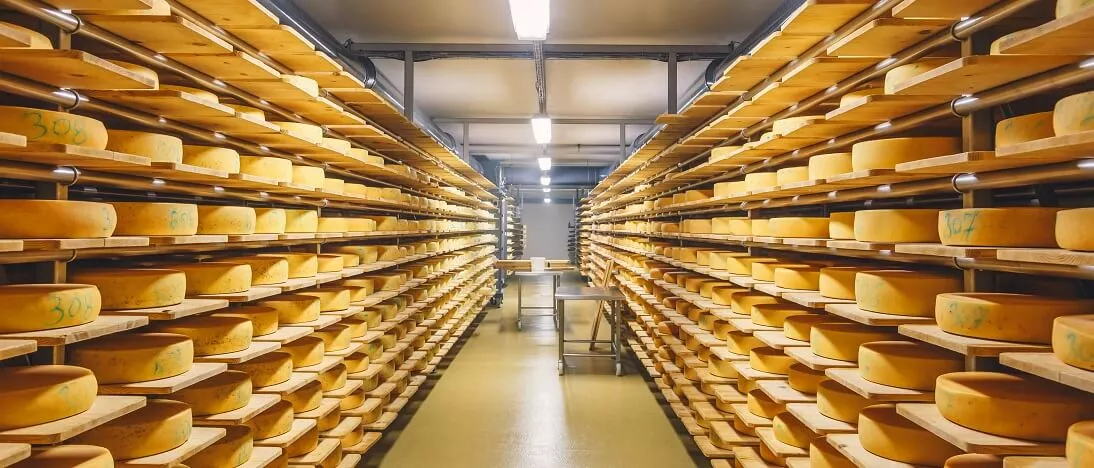Manchego cheese refrigeration
INTARCON2024-03-27T17:20:12+01:00Refrigeration is vital in the production of Manchego cheese. The milk comes from Manchego sheep, mainly in Castilla y León and Castilla La Mancha.
Consumption in Spain remains stable at between 5,000 and 6,000 tonnes per year, while exports have increased. The main consumer countries include the United States, the United Kingdom and Germany.
Manchego cheese production process
The manufacturing process of Manchego cheese begins first with the sheep’s milk, which can be raw or pasteurised. This milk is then fermented by means of lactic cultures to start the production process. After fermentation, the curd is curdled and cut, which marks a crucial stage in the formation of the cheese. The resulting paste is then heated and moulded to give the cheese the desired shape. The cheeses are then salted by immersing them in vats of brine with a concentration of 22-24 % at a temperature of approximately 12 °C for at least two days. This step is essential for the development of the cheese’s flavour and texture.
Finally, the drying and ripening process begins, where the cheeses are placed in controlled conditions of temperature and humidity to acquire their final characteristics. At this stage, the refrigeration of Manchego cheese plays a vital role, as it maintains the optimum conditions for the development of the desired flavours and texture. It is during this period that the maturing process of the Manchego cheese is completed, which can vary depending on the type of maturing desired, whether it is soft, semi-cured, cured or aged. In short, each stage in the manufacturing process of Manchego cheese is crucial to guaranteeing the quality and characteristic flavour of this highly prized product.

Manchego cheese refrigeration in the production process: Drying and ripening
According to the Ministerial Order of 23 November 1995, the maturing of Manchego cheese must take a minimum of 60 days from the date of moulding, and may take up to 270 days in the case of older cheeses. During this time, the brushing, turning and oiling processes deemed necessary for the cheese to acquire its characteristics are applied.
Drying
The cheese is kept in a room with a relative humidity of 70 % to 80 % and a temperature of approximately 12 °C for the first few days, ending at 8 °C, with a weight loss of 8 %. Under these conditions the cheese is left for 30 days.
Maturation
For 60 days, up to a maximum of 240 days, the cheeses are kept in a chamber at a temperature that gradually drops from 8 °C to 4 or 5 °C and with a relative humidity of 80 to 85 %.
These chambers or drying rooms vary in size and type. Specific dryers are used and the air distribution is done by means of special nozzles. The stacking and handling system in each case is also different in each cheese factory, but in all cases, one of the objectives to be met is the homogeneity of the product and therefore the careful distribution of air and its speed in order not to damage the cheese and to obtain a homogeneous production.
Pathologies in the production of Manchego cheese
| Pathogens | Food-borne diseases | Features |
| Sheep’s milk (litres) | Diphtheria | |
| Bacterial brucellosis | Brucellosis in cattle and undulant fever in humans | |
| Coagulant, enzymes (g) | Human tuberculosis | |
| Staphylococcus | Food poisoning caused by enterotoxin | Produces heat-stable enterotoxins |
| Escherichia coli (most commonly E.coli 0157 H7) | Food poisoning caused by by enterotoxins | Causes haemorrhagic diarrhoea |
| Campylobacter jejuni | Food poisoning (diarrhoea) | |
| Listeria monocytogenes | Causes septicaemia, meningitis or encephalitis | Thermostable toxins allowing growth at extreme temperatures |
| Bacillus cereus | Food poisoning | Thermostable spores surviving pasteurisation |
Resistance time profile of the HTST pasteuriser.
Nominal process: 72 °C, 16 s and 90 °C regeneration.
Pasteurisation of cheese milk
In addition to the processes described above, pasteurisation of the milk is used for the production of cheese from raw milk and for the elimination of pathogenic germs. Milk intended for cheese production is generally pasteurised at 70 °C (71,3 °C) in 15 to 20 seconds in the rapid process and at 65 °C in 30 minutes in the slow process.
At higher temperatures the calcium would precipitate as calcium triphosphate, which is insoluble, leading to defective coagulation.
Examples of cooling capacities required in the drying phase for the refrigeration of Manchego cheese:
| Temperature and Humidity relative | Dimensions | Surface area (m2) | Volume (m3) | Capacity (kg) | Extraction (l/d) | Function (h) | Extraction (l/d) | Power expected (kW) | |||
| m | m | m | |||||||||
| CHEESE DRYING ROOM Nº 1 to Nº 8 | +11 °C / 80 % | 18 | 34,2 | 7 | 615,6 | 4309,2 | 579600 | 1545,6 | 20 | 77,28 | 165 |
| Drying room CHEESE Nº9 | +11 °C / 80 % | 11,58 | 34,2 | 7 | 396,6 | 2772,25 | 309600 | 825,6 | 20 | 41,28 | 105 |
| Painted CHEESE dryer Nº 1 to Nº 8 | +11 °C / 80 % | 12,32 | 34,2 | 7 | 421,34 | 2949,41 | 309600 | 825,6 | 20 | 41,28 | 105 |
| Havarti bar dryer Nº1 and Nº2 | +11 °C / 80 % | 12,1 | 34,2 | 7 | 413,82 | 2896,74 | 309600 | 825,6 | 20 | 41,28 | 105 |
| Mini CHEESE dryer Nº1 | +11 °C / 80 % | 16,1 | 34,2 | 7 | 550,62 | 3854,34 | 579600 | 1545,6 | 20 | 77,28 | 165 |
| Mini CHEESE dryer Nº2 | +11 °C / 80 % | 16,1 | 34,2 | 7 | 550,62 | 3854,34 | 500400 | 1334,4 | 20 | 66,72 | 165 |
Examples of cooling capacities required in the maturing phase for the refrigeration of Manchego cheese:
| Dimensions | Surface area (m2) | Volume (m3) | Capacity (kg) | Extraction (l/d) | Function (h) | Extraction (l/d) | Power expected (kW) | ||||
| Relative humidity | m | m | m | ||||||||
| CHEESE DRYING ROOM Nº 1 to Nº 8 | +5 °C / 80 % | 18 | 34,2 | 7 | 615,6 | 4.309,20 | 579.600 | 362,25 | 20 | 25,88 | 75 |
| Drying room CHEESE Nº9 | +5 °C / 80 % | 11,58 | 34,2 | 7 | 396,6 | 2.772,25 | 309.600 | 193,5 | 20 | 13,82 | 40 |
| Painted CHEESE dryer Nº 1 to Nº 8 | +5 °C / 80 % | 12,32 | 34,2 | 7 | 421,34 | 2.949,41 | 309.600 | 193,5 | 20 | 13,82 | 40 |
| Havarti bar dryer Nº1 and Nº2 | +5 °C / 80 % | 12,1 | 34,2 | 7 | 413,82 | 2.896,74 | 309.600 | 193,5 | 20 | 13,82 | 40 |
| Mini CHEESE dryer Nº1 | +5 °C / 80 % | 16,1 | 34,2 | 7 | 550,62 | 3.854,34 | 579.600 | 362,25 | 20 | 25,88 | 75 |
| Mini CHEESE dryer Nº2 | +5 °C / 80 % | 16,1 | 34,2 | 7 | 550,62 | 3.854,34 | 500.400 | 362,25 | 20 | 22,34 | 65 |
Finished product chambers in Manchego cheese refrigeration.
Once the cheese has been produced in the maturing chambers, it awaits distribution, which can take up to six months. The cheese is stored in cold stores at a temperature of around 6 °C with a relative humidity of around 90 %.
The quality and hygiene of the air in these chambers must be ensured by air renewal, pre-filtering and subsequent pressurisation.
In large installations, air-conditioning systems with bactericidal systems are used to eliminate the need to brush the cheeses.
Compulsory rules for the production of Manchego cheese
- The milk must be from Manchega breed sheep.
- Minimum maturing period of 30 days for cheeses weighing 1,5 kg or less and 60 days for all other formats. Maximum maturity of two years.
- Cylindrical in shape, with noticeably flat sides and a maximum height of 12
- cm. Maximum diameter 22 cm.
- Minimum weight 400 g and maximum 4 kg.
- Minimum dry matter 55 %. Fat content minimum 50 % of the dry matter.
- Total protein minimum 30 % of dry matter.
- Pale yellow or greenish-blackish hard rind, with the zigzag marks of the esparto straps and ‘flower-like’ marks on the flat sides being visible on the surface.
- Small, irregular eyes in the paste.
- The labels include the words ‘Denominación de Origen Queso Manchego’ and numbered back labels issued by the Regulatory Board, together with casein plates.






